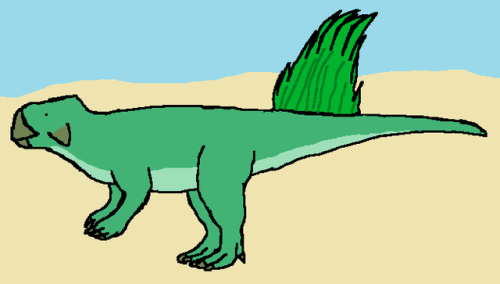#my very good parrot-faced friend
Psittacosaurus – Early Cretaceous (126-101 Ma)
I’m a mess. I’ve been running this blog for a long time, and I barely talk about dinosaurs. I was thinking about the dinosaurs I’ve drawn, and I haven’t even covered most of the famous groups, including ceratopsians. Mess.
So let’s talk about a ceratopsian. Ceratopsians were the dinosaurs who looked like Triceratops; frill, facial horns, beak, etc. This little guy is named Psittacosaurus, which means “parrot lizard.” It was about the size of a golden retriever, and was a more basal sort of ceratopsian. It has no frill, only a ridge on the back of the skull. It had two spikes on its cheeks—one species even has horns protruding from the front of the skull, but it’s likely convergent evolution, not a directly ancestral trait for future ceratopsians. It was still a biped, though, even as an adult. Its remains are found in eastern Asia, from Russia, China, and famously, Mongolia. We’ve found hundreds of fossils of 11 different species and from all stages of life. This is one of the dinosaurs we have an almost complete image of.
Psittacosaurus was an efficient little herbivore, with a tough beak and a battery of self-sharpening teeth. Desert plants tend to be hardier and thicker, and these teeth let it slice through those tough desert plants without a problem. It also swallowed stones to aid the digestion process. This is a behavior seen in many herbivores today. Plants are kind of hard to digest, so plenty of animals swallow rocks to help grind up their food. Psittacosaurus had big eyes and, surprisingly, a pretty big brain. They built nests and took care of their hatchlings. They were probably comparable to a sparrow in terms of intelligence, which is a reminder that despite popular thought, dinosaurs weren’t stupid.
Speaking of bipedalism, this animal has kind of a weird relationship with the concept of walking on two legs. Its young may have been quadrupedal, suggesting it evolved from a quadrupedal ancestor. So, this means one of two things: 1) Ceratopsians evolved from quadrupeds, became bipeds, and then went back to walking on all fours, or 2) This is a more derived ceratopsian that branched off from the line leading to the big guys from later on. The former isn’t as wacky as it sounds—other animals have done it in their history. The latter is just as likely, though. This sort of thing is really hard to determine in animals who are a hundred million years old.
Unlike its descendants, Psittacosaurus was agile and quick on its feet. Later ceratopsians were more like tank builds. When something wanted to eat a Triceratops or its babies, it’d hunker down and wave its horns and frill and warn the predator to piss off. But in Psittacosaurus’ case, it was the one doing the pissing off. It was small, so it makes sense that it would want to run away instead of trying to fight. We’ve also learned, through molecular studies, that its skin was countershaded. Countershading is a type of camouflage common in a lot of animals, where the top half of its body is dark, and its belly is lighter. This makes it harder to see them by messing with their shading. Deer, dolphins, and manta rays are some of the many animals that do this today. Psittacosaurus likely depended on this to avoid being spotted by theropods, who hunted primarily with eyesight.
Another cool thing we learned about this guy fairly recently is the brush of quills on its tail. Now, this is kind of weird for a few reasons. Dinosaurs are divided into two big groups, Ornithischia and Saurischia. Birds originated in Saurischia, and many, many Saurischians had feathers. The exception is sauropods, although they might have had quills on their back. It makes sense to think that feathers originated in this branch.
BUUUUUUUUUUUT
A few groups of Ornithischians had quills, like Psittacosaurus. So, it’s been proposed that feathers are an ancestral trait for all dinosaurs, and that the most recent common ancestor of all of them was at least fuzzy. Although, the quills in Psittacosaurus were different from those of their distant birdlike cousins. They had a conelike structure and might have been filled with some sort of fluid. They may have even been covered in keratin, making them quite different from what we usually call ‘feathers.’ They’re also only found on a very particular and unusual part of the body. The most convincing study on these weird quill things has concluded that they aren’t really similar enough to be considered homologous to theropod feathers, and probably evolved independently. Mind you, we don’t know for sure, and fuzzy Coelophysis isn’t completely unreasonable. Given sauropods may have had quills, maybe those were the ancestral structure, and theropods just went buckwild with them.
Also, this means Triceratops may have had a sparse smattering of quills on its butt, which I like a lot. I’ll draw a bigger ceratopsian with quills at some point and it’ll be a fun time.
One more thing about Psittacosaurus, and it’s not really particularly scientific, but this thing is SO CUTE. I want one as a pet. Maybe it would be kinda spiky, and maybe it wouldn’t be great for petting, but I think it would be a good friend.
That’s all for today’s animal, a dinosaur whom I love very much. I think from now on, I will make more of an effort to draw more famous dinosaurs, because a lot of them are well-known and I like a lot of them. I just don’t want to get it all out of my system at once, you know?
******************************************************************************
Buy me a Coffee, if you’d like!
Post link

